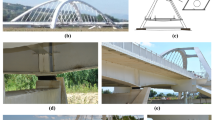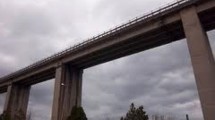Abstract
An object prestressed concrete bridge with a 37.47 m span that vibrated greatly upon a truck running on it was investigated through examination and monitoring to clarify the cause of the vibrations. The results of running examinations showed that the bridge vibrated greatly only when the test truck ran in the 2nd slow lane, and the bridge resonated with the truck suspension’s spring vibration that was caused by the road roughness with a certain spatial wavelength in that lane. Then, monitoring was conducted in a 2.5 year period before and after the repair of the periodic roughness to detect the abnormal stress due to large dynamic amplification and to confirm the effect of reduction and validation of the repair under the movement of ordinary trucks. The monitoring results showed that the diurnal maximums of the dynamic stress after repair decreased by 40 %, and the diurnal maximum dynamic increment factor DIF-1 after repair decreased to approximately one-third. Moreover, dynamic response analysis was performed to investigate the relation among the bridge dynamic amplification and various periodic roughnesses with long spatial wavelengths at the expansion joint. The simulation results showed that a periodic roughness with a spatial wavelength of 10 m affected the dynamic amplification of the bridge when the truck model runs over it at a speed of 80 km/h.





























Similar content being viewed by others
References
Brady SP, O’Brien E, Znidaric A (2006) Effect of vehicle velocity on the dynamic amplification of a vehicle crossing a simply supported bridge. J Bridge Eng 11(2):241–249
Broquet C, Bailey SF, Fafard M, Brühwiler E (2004) Dynamic behavior of deck slabs of concrete road bridges. J Bridge Eng 9(2):137–146
Green MF, Cebon D, Cole DJ (1995) Effects of vehicle suspension design on dynamics of highway bridges. J Struct Eng 121(2):272–282
O’Brien E, Li Y, Gonzalez A (2006) Bridge roughness index as an indicator of bridge dynamic amplification. Comput Struct 84:759–769
Li Y, O’Brien E, Gonzalez A (2006) The development of a dynamic amplification estimator for bridges with good road profiles. J Sound Vib 293:125–137
Fukada S (2006) Infrasound and vibration of short span bridge due to running vehicle. In: Proc. of Inter-noise: No. 078 (on CD-ROM)
Fukada S, Kajikawa Y, Sugimoto M, Hama H, Matsuda T (2007) Characteristics of vibration and low frequency noise radiated from the highway bridge and countermeasure. In: Proceedings of 19th International Congress on Acoustics: ENV11-001-IP (on CD-ROM)
Fukada S, Hama H, Usui K (2012) Relation of the infrasound characteristics and the continuous steel bridge vibration modes generated by the vibration of moving heavy trucks. J Mod Transp 20(3):185–196
Fukada S, Usui K, Yoshimura T, Okada T, Hama H, Kishi T (2012) Effectiveness of dampers in controlling a vibration problem near a highway bridge. J Civil Struct Health Monit 2(2):109–122
Shi XM, Cai CS, Chen S (2008) Vehicle induced dynamic behavior of short-span slab bridges considering effect of approach slab condition. Journal of Bridge Engineering 13(1):83–92
Zhang HL, Hu CS (2007) Determination of allowable differential settlement in bridge approach due to vehicles vibrations. J Bridge Eng 12(2):154–163
Fukada S, Matsumoto T, Aiba T, Okada H, Momiyama Y (2012) Proposition of estimation method for repairing the roughness in expansion joints of expressway bridges. J Appl Mech Mater 256–259:1742–1747
ISO 8608 (1995) Mechanical vibration—road surface profiles—reporting of measured data
Sayers MW, Gillespie TD, Paterson WDO (1986) Guidelines for the conduct and calibration of road roughness measurements. World Bank Technical Paper, No. 46
Kim CW, Kawatani M, Kim KB (2005) Three-dimensional dynamic analysis for bridge-vehicle interaction with roadway roughness. Comput Struct 83:1627–1645
Nassif HH, Liu M, Ertekin O (2003) Model validation for bridge-road-vehicle dynamic interaction system. J Bridge Eng 8(2):112–120
Chang D, Lee H (1994) Impact factors for simple-span highway girder bridges. J Struct Eng 120(3):704–715
Moses F (1979) Weigh-in-motion system using instrument bridges. Transp Eng J 105(3), 114:233–249
Yamada K, Ojio T, Fukada S, Kajikawa Y (2004) Use of bridge weigh-in-motion system with environmental monitoring of viaducts. In: Proc. of second international workshop on structural health monitoring of innovative civil engineering structures, pp 335–345
Cardini AJ, DeWolf JT (2009) Implementation of a long-term bridge weigh-in-motion system for a steel girder bridge in the interstate highway system. J Bridge Eng 14(6):418–423
Hwang ES, Nowak AS (1991) Simulation of dynamic load for bridges. J Struct Eng 117(5):1413–1434
Green MF, Cebon D (1994) Dynamic response of highway bridges to heavy vehicles loads: theory and experimental validation. J Sound Vib 170(1):51–78
Yang YB, Yau JD (1997) Vehicle-bridge interaction element for dynamic analysis. J Struct Eng 123(11):1512–1518
Guo WH, Xu YL (2001) Fully computerized approach to study cable-stayed bridge-vehicle interaction. J Sound Vib 248(4):745–761
Shi XM, Cai CS (2009) Simulation of dynamic effects of vehicles on pavement using a 3D interaction model. J Transp Eng 135(10):736–744
Fukada S (2007) Dynamic response analysis of a test bridge due to running vehicle. In: Proceedings of IMAC XXV: No. 046
Author information
Authors and Affiliations
Corresponding author
Appendix
Appendix
The following steps are carried out for solving the bridge-truck interaction system:
-
1.
Form mass M, damping C, and stiffness K matrices of the bridge and truck models.
-
2.
Initialize displacement, velocity, and acceleration vectors of the bridge and truck.
 (A1)
(A1) -
3.
Select time step size Δt and integration parameters in the Newmark β method α, β, a0–a7.
$$\alpha \geqslant 0.5, \, \beta \geqslant 0.25{(0.5 + \alpha )^2}.$$(A2)$${{\text{a}}_0} = \frac{1}{{\beta \Delta {t^2}}},\,{{\text{a}}_1} = \frac{\alpha }{\beta \Delta t},{{\text{a}}_2} = \frac{1}{\beta \Delta t},{{\text{a}}_3} = \frac{1}{2\beta } - 1,{{\text{a}}_4} = \frac{\alpha }{\beta } - 1,{{\text{a}}_5} = \frac{\Delta t}{2}(\frac{\alpha }{\beta } - 2),{{\text{a}}_6} = \Delta t(1 - \alpha ),{{\text{a}}_7} = \alpha \Delta t.$$(A3) -
4.
Form the effective stiffness matrix \({\hat K_b}\) and \({\hat K_v}\) for the bridge and truck, respectively.
$${\hat K_b} = {K_b} + {{\text{a}}_0}{M_b} + {{\text{a}}_1}{C_b}.$$(A4)$${\hat K_v} = {K_v} + {{\text{a}}_0}{M_v} + {{\text{a}}_1}{C_v}.$$(A5) -
5.
Check the current position of the truck at time t. If the contact point of the truck wheel lies outside the bridge, each reaction force of the truck \(^{t + \varDelta t}{f_v}\) is calculated using the road roughness of the approach road at the contact point. Furthermore, if the contact point of the truck wheel lies on the bridge, each reaction force of the truck \(^{t + \varDelta t}{f_v}\) is calculated using the displacement and road roughness of the bridge at the contact point.
 (A8)
(A8) -
6.
Form the force vector of the bridge \(^{t + \varDelta t}{f_b}\) using the reaction force of the truck if the truck acts on the bridge.
-
7.
Solve the displacement of the bridge \({}^{t + \varDelta t}{u_b}\).
 (A9)
(A9) -
8.
Using the calculated new displacement \({}^{t + \varDelta t}{u_b}\), iterate steps 5–7 until the convergent value \({}^{t + \varDelta t}{u_b}\) is obtained.
-
9.
Calculate the acceleration and velocity of the bridge and truck at time t + Δt.
 (A10)
(A10) (A11)
(A11) (A12)
(A12) (A13)
(A13) -
10.
Go to step 5 by setting the next time t = t + Δt.
 (A14)
(A14) (A15)
(A15)
Rights and permissions
About this article
Cite this article
Fukada, S., Matsumoto, T., Okada, H. et al. Dynamic response of bridge affected by periodic roughness with a long spatial wavelength. J Civil Struct Health Monit 4, 149–163 (2014). https://doi.org/10.1007/s13349-013-0071-2
Received:
Revised:
Accepted:
Published:
Issue Date:
DOI: https://doi.org/10.1007/s13349-013-0071-2













